#Bhutan culture and traditions
Explore tagged Tumblr posts
Text
Bhutan Travel: Discover the Hidden Gem of the Himalayas in 2024
Bhutan Travel: Discover the Hidden Gem of the Himalayas in 2024 Looking for a destination that combines breathtaking landscapes, rich culture, and sustainable tourism? Welcome to Bhutan, the “Land of the Thunder Dragon.” Nestled in the majestic Himalayas, Bhutan offers a travel experience unlike any other. With its unspoiled beauty, vibrant traditions, and focus on happiness over materialism,…
#Best places to visit in Bhutan#Bhutan adventure activities#Bhutan culture and traditions#Bhutan tourism 2024#Bhutan travel guide#Bhutan travel tips#Bhutan trekking routes#Bhutan visa requirements#Sustainable tourism in Bhutan#Tiger&039;s Nest Monastery Bhutan
0 notes
Text

Bhutanese man, Bhutan, by Bhutanese Street fashion
#bhutanese#bhutan#asia#south asia#folk clothing#traditional clothing#traditional fashion#cultural clothing
251 notes
·
View notes
Text
Bhutan Festival 2025: A Cultural Extravaganza in the Land of the Thunder Dragon
Bhutan, the mystical Himalayan kingdom known for its stunning landscapes and deep-rooted traditions, is set to host a series of vibrant festivals in 2025. These festivals, known as 'Tsechus,' offer a unique blend of spirituality, culture, and entertainment, making Bhutan a must-visit destination for travelers seeking an authentic cultural experience. As we dive into the highlights of Bhutan Festival 2025, let's explore the rich tapestry of Bhutanese culture, the significance of these festivals, and essential travel tips to make the most of your visit.

The Significance of Tsechus: More Than Just Festivals
Tsechus are annual religious festivals held in various districts across Bhutan, honoring Guru Rinpoche, the saint who introduced Buddhism to the region. These festivals are not only spiritual gatherings but also social events that bring communities together. Featuring colorful mask dances, traditional music, and elaborate costumes, Tsechus provide a glimpse into Bhutan’s rich heritage and Buddhist traditions.
In 2025, Bhutan will host Tsechus in iconic locations like Paro, Thimphu, Punakha, and Bumthang. Each Tsechu is unique, offering distinct performances and rituals that reflect the local culture and history.
Top Bhutan Festivals to Experience in 2025
1. Paro Tsechu (April 2025)
Paro Tsechu is one of Bhutan's most popular festivals, attracting thousands of locals and tourists alike. Held at the majestic Rinpung Dzong, this festival features the famous mask dances and the unfurling of the giant Thangka (religious scroll), believed to bless all who view it. The festival is also an excellent opportunity to witness the traditional Bhutanese attire, 'Gho' for men and 'Kira' for women, in all its glory.
2. Thimphu Tsechu (September 2025)
The capital city of Thimphu comes alive during the Thimphu Tsechu, held at the Tashichho Dzong. This festival offers a mix of spiritual and cultural performances, including the sacred Cham dances. The vibrant atmosphere, coupled with the backdrop of the stunning fortress, makes it an unforgettable experience.
3. Punakha Drubchen and Tsechu (March 2025)
Punakha, the ancient capital of Bhutan, hosts the Punakha Drubchen and Tsechu in March. The Drubchen reenacts the historic battle against Tibetan invaders, while the Tsechu features traditional mask dances and religious rituals. The Punakha Dzong, located at the confluence of the Pho Chu and Mo Chu rivers, adds to the charm of this festival.
4. Jambay Lhakhang Drup (November 2025)
Held at the ancient Jambay Lhakhang temple in Bumthang, this festival is renowned for the sacred fire dance and the mystical 'Dance of the Black Hats.' Jambay Lhakhang Drup is a blend of spirituality and festivity, attracting pilgrims and tourists from all over the world.
5. Haa Summer Festival (July 2025)
The Haa Summer Festival showcases the nomadic lifestyle of the Haa Valley. This lesser-known festival offers an intimate experience of Bhutanese culture, with activities like yak riding, traditional games, and authentic Bhutanese cuisine. The serene beauty of the Haa Valley adds to the allure of this festival.
Why Visit Bhutan During Festival Season?
Visiting Bhutan during the festival season provides a deeper understanding of the country's cultural fabric. The festivals are not just visual spectacles but also spiritual experiences that reflect Bhutanese values of peace, harmony, and devotion. Here are some reasons to plan your trip around Bhutan Festival 2025:
Cultural Immersion: Witness ancient rituals, mask dances, and traditional music.
Photographic Opportunities: Capture vibrant costumes, stunning architecture, and scenic landscapes.
Unique Souvenirs: Explore local markets for handmade crafts, textiles, and traditional masks.
Warm Hospitality: Experience the genuine warmth and hospitality of the Bhutanese people.
Travel Tips for Bhutan Festival 2025
Plan Early: Bhutan has a tourist cap to preserve its environment and culture. Book your flights, accommodation, and festival passes well in advance.
Respect Local Customs: Dress modestly, ask for permission before taking photos, and follow local etiquette during festivals.
Acclimatize Gradually: Bhutan's high altitude can be challenging. Spend a few days acclimatizing to avoid altitude sickness.
Pack Wisely: Carry comfortable clothing, sturdy footwear, and essentials like sunscreen, hats, and reusable water bottles.
Engage with Locals: Learn about Bhutanese culture firsthand by interacting with locals and participating in festival activities.
Conclusion
Bhutan Festival 2025 promises an unforgettable journey into the heart of Bhutanese culture. From the grand Paro Tsechu to the intimate Haa Summer Festival, each celebration offers a unique experience that will leave you mesmerized. As you plan your trip, let the vibrant festivals, serene landscapes, and warm hospitality of Bhutan create memories that last a lifetime.
Whether you're an avid traveler, a cultural enthusiast, or a photography lover, Bhutan's festivals in 2025 are the perfect reason to explore this enchanting kingdom. Start planning your adventure today and immerse yourself in the magic of Bhutan!
#bhutan cultural festival#bhutan festival 2025#bhutanese mask dance#bhutanese traditions#paro tsechu#thimpu tsechu
0 notes
Text
Discovering Bhutan: The Last Shangri-La
Nestled in the Eastern Himalayas, Bhutan, known as the “Land of the Thunder Dragon,” is a country that beckons travelers with its pristine landscapes, vibrant culture, and profound spirituality. As one of the world’s last remaining Buddhist kingdoms, Bhutan offers a unique blend of ancient traditions and modern sensibilities. In this travel guide, we’ll explore Bhutan’s history, political…
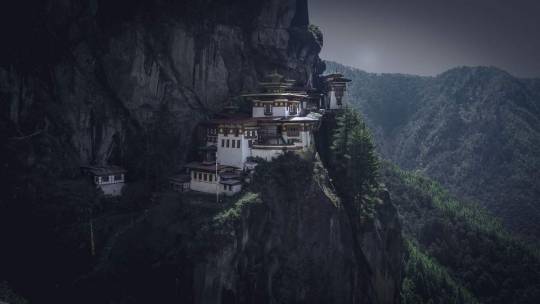
View On WordPress
#" is a country that beckons travelers with its pristine landscapes#adventure#africa#all international tourists (excluding Indian#all international tourists need a visa arranged through a licensed tour operator#and a guide#and a guide. This policy helps manage tourism sustainably and preserves the country&039;s unique culture. Currency and Bank Cards The offic#and archery. Safety Bhutan is one of the safest countries for travelers. Violent crime is rare#and Buddha Dordenma statue. Punakha: Known for the majestic Punakha Dzong#and cultural insights to help you plan an unforgettable journey. Brief History of Bhutan Bhutan&039;s history is deeply intertwined with Bu#and Culture Religion: Buddhism is the predominant religion#and experiencing a traditional Bhutanese meal are top cultural activities. Is it safe to travel alone in Bhutan? Bhutan is very safe for sol#and Kathmandu. Infrastructure and Roads Bhutan&039;s infrastructure is developing#and Maldivian passport holders) must obtain a visa through a licensed Bhutanese tour operator. A daily tariff is imposed#and red rice. Meals are typically spicy and incorporate locally sourced ingredients. Culture: Bhutanese culture is characterized by its emph#and respectful clothing for visiting religious sites. Bhutan remains a land of mystery and magic#and stupas are common sights. Food: Bhutanese cuisine features dishes like Ema Datshi (chili cheese)#and the locals are known for their hospitality. However#and vibrant festivals. Handicrafts#Bangladeshi#Bhutan#Bhutan offers a unique blend of ancient traditions and modern sensibilities. In this travel guide#Bhutan promises an experience unlike any other. Plan your journey carefully#Bhutan was never colonized. The country signed the Treaty of Sinchula with British India in 1865#but English is widely spoken and used in education and government. What should I pack for a trip to Bhutan? Pack layers for varying temperat#but it covers most expenses#but it&039;s advisable to carry cash when traveling to remote regions. Top Places to Visit in Bhutan Paro Valley: Home to the iconic Paro T#but it&039;s advisable to carry cash when traveling to rural regions. What are the top cultural experiences in Bhutan? Attending a Tshechu#but they offer stunning views. Religion#comfortable walking shoes
0 notes
Text

Discover the mesmerizing allure of the Burning Lake in Tang, Bhutan. Nestled in the serene landscapes of Bumthang, this hidden gem captivates with its mystical ambience and cultural significance. The sacred site, Mebar Tsho, unfolds tales of spiritual revelations and is a haven for introspection. Immerse yourself in the ethereal beauty of nature as the turquoise waters mirror the surrounding mountains. Embark on a journey to this Bhutanese marvel, where tradition meets tranquillity, creating an unforgettable experience.
#Burning Lake Tang#Bumthang#spiritual significance#Bhutan#Mebar Tsho#cultural heritage#enchanting landscapes#Bhutanese marvel#turquoise waters#hidden gem#mystical ambience#serene beauty#sacred site#tradition#tranquillity#spiritual revelations#introspection#cultural exploration.
0 notes
Text
Bhutan's Hidden Gems: Off-the-Beaten-Path Destinations

Bhutan, renowned for its majestic landscapes and vibrant culture, has become a sought-after destination for travellers seeking a unique experience. Beyond the well-known attractions such as the Tiger's Nest and Paro Taktsang, hidden gems like serene hot springs in Bhutan and Bhutan charming hotels and resorts are waiting to be explored by those eager to venture off the beaten path.
The Charm of Bhutan's Off-the-Beaten-Path Destinations
In a world where overtourism is a growing concern, off-the-beaten-path destinations in Bhutan offer a refreshing escape. These lesser-known places possess a certain charm that comes from their untouched beauty and the sense of discovery they provide.
Mystical Monasteries Tucked Away

Bhutan is renowned for its monasteries, but beyond the well-known ones lie hidden spiritual sanctuaries. Exploring these lesser-known monastic wonders allows travelers to connect with the country's rich spiritual heritage in a more intimate setting.
Serene Nature Retreats
For nature enthusiasts, Bhutan's offbeat destinations promise a serene escape. Unspoiled landscapes, rare flora, and fauna await those who seek the road less traveled. These natural retreats offer a peaceful haven, away from the hustle and bustle of more popular tourist spots.
Local Culture and Traditions
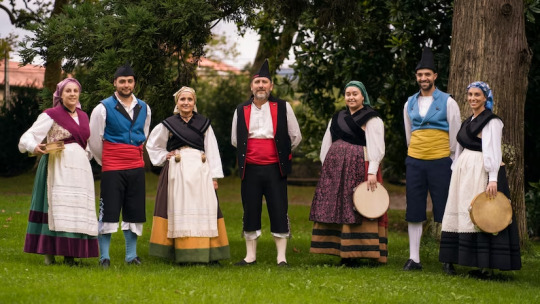
One of the joys of exploring off-the-beaten-path destinations is the opportunity to immerse oneself in the authentic Bhutanese way of life. Witness traditional festivals celebrated in remote areas, providing a genuine cultural experience that goes beyond the surface.
Adventure Beckons: Trekking Beyond the Usual Trails
For the adventure seekers, Bhutan offers lesser-explored trekking routes that lead to breathtaking vistas. Trekking beyond the usual trails provides a sense of adventure and a chance to discover hidden valleys, pristine lakes, and panoramic mountain views.
Hidden Culinary Delights

Bhutan's hidden gems extend to its culinary offerings. Discover unique local cuisines in remote areas, each dish telling a story of tradition and local flavours. The joy of stumbling upon hidden culinary treasures adds a delightful aspect to the off-the-beaten-path experience.
Sustainable Tourism in Bhutan
In the spirit of Gross National Happiness, Bhutan is committed to sustainable tourism. Off-the-beaten-path destinations play a crucial role in this, as they promote responsible travel and contribute to the conservation of Bhutan's natural and cultural heritage.
Connecting with Locals
One of the most rewarding aspects of exploring hidden gems is the chance to connect with local communities. The warmth and hospitality of Bhutanese people shine even brighter in these remote areas, creating authentic and meaningful interactions.
The Challenges of Exploring Hidden Gems

While the allure of off-the-beaten-path destinations is undeniable, it comes with its set of challenges. From limited infrastructure to rugged terrain, travelers need to be prepared for the unique obstacles these hidden gems present.
Best Time to Explore Bhutan's Hidden Gems
Seasonal considerations are crucial when planning a trip to Bhutan's lesser-known locations. Understanding the weather patterns ensures that travelers can make the most of their visit, whether it's to witness vibrant festivals or enjoy the tranquility of nature.
Planning Your Off-the-Beaten-Path Itinerary
Crafting the perfect off-the-beaten-path itinerary involves striking a balance between popular and hidden destinations. A flexible plan allows for spontaneous discoveries while ensuring that travelers don't miss out on Bhutan's iconic landmarks.
Capturing Unforgettable Moments

Photography enthusiasts will find Bhutan's hidden gems to be a treasure trove of picturesque scenes. Tips for capturing the essence of these locations through photography ensure that every moment becomes a lasting memory.
Personal Experiences and Traveler Testimonials
Real-life stories from travelers who ventured into Bhutan's hidden gems provide a glimpse into the unique experiences awaiting explorers. Their testimonials offer insights and recommendations, inspiring others to embark on their own journey of discovery.
Conclusion
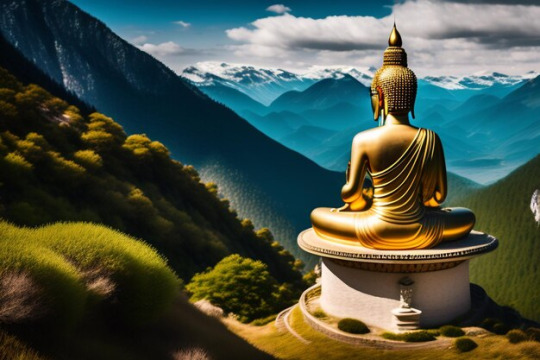
In the heart of Bhutan's off-the-beaten-path destinations lies a world of beauty and significance waiting to be explored. Whether seeking spiritual solace, natural wonders, or cultural immersion, these hidden gems offer a unique and enriching travel experience. As we celebrate the allure of Bhutan beyond the usual tourist spots, may this article inspire you to pack your bags and uncover the treasures that await.
#Bhutan hot springs#Hidden gems in Bhutan#Off-the-beaten-path destinations#Unique Bhutanese experiences#Tiger's Nest exploration#Paro Taktsang wonders#Bhutanese monasteries#Nature retreats in Bhutan#Local culture and traditions#Adventure trekking in Bhutan#Culinary delights in remote Bhutan#Sustainable tourism Bhutan#Connecting with locals in Bhutan#Challenges of offbeat travel#Best time to visit Bhutan
0 notes
Text
Win Free Flight Tickets Back to Bhutan! | Daily Bhutan
Have you visited Bhutan? Here's your chance to win free flight tickets and revisit this stunning country! Join now for your opportunity to return to Bhutan with Daily Bhutan. Explore the details and enter today!
0 notes
Text
Cultural Fashion: Tsemo

Tsemo is a character from the Avatar Legends: The Roleplaying Game Core Book. She is a post-Harmonic Convergence airbender. Her outfit is inspired by the traditional women’s clothing of Bhutan.
Traditional Bhutanese skirts are called kira (དཀྱི་ར) and are characterized by their elaborate designs of diamond shapes and horizontal lines, which Tsemo’s skirt shares. However, the silhouette of Tsemo’s skirt is A-line rather than rectangular. This modification was likely for ease of movement and to add to her overall airbender aesthetic.
Traditional Bhutanese tops are made up of two layers. The first layer is a blouse called a wonju (འོན་འཇུ་), while the second layer is a short jacket called a toego (སྟོད་གོ་). The sleeves of the wonju are folded over the sleeves of the toego to create prominent cuffs. You can also see the collar of the wonju peeking out of the toego as well. Tsemo’s top has both these details, with her blouse being dark brown and her jacket being saffron. Finally, the anklets she wears resemble traditional Bhutanese bangles called dhopchuu (གདོབ་ཅུ).
Overall, Tsemo’s character design might be one of my favorites in the whole franchise. It’s eye-catching yet practical, and the cultural inspiration is spot-on. Bhutan is a mountainous Himalayan nation that practices Tibetan Buddhism, so it’s the perfect source to draw from for an Air Nomad character. Bhutanese architecture is also the basis for the Western Air Temple.
I also have to admit that--- for all the issues I have with the Avatar TTRPG--- the art is fantastic. The style is like the perfect halfway point between the rounded ATLA look and the angular Korra look.
Like what I’m doing? Tips always appreciated, never expected. ^_^
https://ko-fi.com/atlaculture
#avatar#atla#Avatar The Last Airbender#Air Nomads#I wish they leaned more into the Himalayan aspect of the Air Nomads in Korra#instead of making them all wear weird flying squirrel superhero suits#avatar legends
521 notes
·
View notes
Text













Bhutan
A Kingdom of the Eastern Himalayas
Guy van Strydonck, Françoise Pommaret- Imaeda, Yoshiro Imaeda
Serindia Publ., London 1984, 175 pages, hardcover, ISBN 0906026 13X
euro 22,00
email if you want to buy [email protected]
The little-known kingdom of Bhutan, around the size of Switzerland, is now one of the last strongholds of Tantric Buddhism in the East. Although isolated for centuries by its geography, bound as it is on the south by dense tropical jungles and to the north by the Himalayas, in the last 15 years with the advent of motor roads and the national will to develop, it has slowly opened its doors to a few privileged vistoirs and tourists. Amongst these, Guy van Strydonck has had the good fortune as royal guest to travel the length and breadth of the kingdom, recording the land and its people. For centuries, monks and refugees from Tibet have settled in Bhutan's hospitable and fertile valleys and ensured close cultural links between the countries. Because of different socio-economic conditions, Bhutan soon developed a highly distinctive culture of its own, and it is the purpose of this book to introduce the reader not only to its magnificent and varied landscapes, but also to the genius of Bhutan's rich traditions of art and architecture. Other chapters in the book focus on monastic and village life, their festivals and dances. A whole chapter is devoted to the hitherto unknown valley of Sakteng in the extreme east, homeland to the yak-herding "brokpas". The book concludes with a portrait of the Bhutanese themselves, a hardy mountain people renowned both for thie irrepresible good humour and for their profound spirit of Buddhist tolerance.
07/06/24
#Bhutan#Guy van Strydonck#photography books#Tantric Buddhism#valley Sakteng#Eastern Himalayas#fashionbooksmilano
63 notes
·
View notes
Text
Stone Turtle of Karakorum, Mongolia, c. 1235-1260 CE: this statue is one of the only surviving features of Karakorum, which was once the capital city of the Mongol Empire
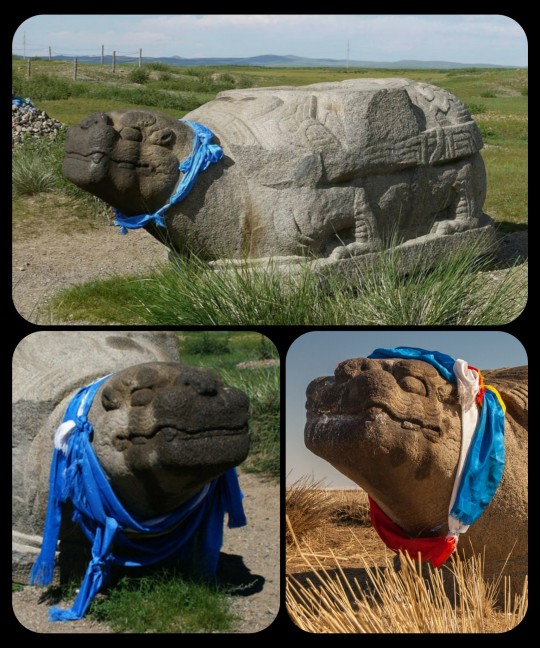
The statue is decorated with a ceremonial scarf known as a khadag (or khata), which is part of a Buddhist custom that is also found in Tibet, Nepal, and Bhutan. The scarves are often left atop shrines and sacred artifacts as a way to express respect and/or reverence. In Mongolia, this tradition also contains elements of Tengrism/shamanism.
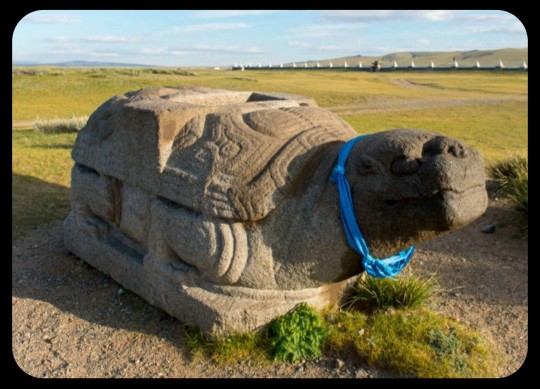
The city of Karakorum was originally established by Genghis Khan in 1220 CE, when it was used as a base for the Mongol invasion of China. It then became the capital of the Mongol Empire in 1235 CE, and quickly developed into a thriving center for trade/cultural exchange between the Eastern and Western worlds.
The city attracted merchants of many different nationalities and faiths, and Medieval sources note that the city displayed an unusual degree of diversity and religious tolerance. It contained 12 different temples devoted to pagan and/or shamanistic traditions, two mosques, one church, and at least one Buddhist temple.
As this article explains:
The city might have been compact, but it was cosmopolitan, with residents including Mongols, Steppe tribes, Han Chinese, Persians, Armenians, and captives from Europe who included a master goldsmith from Paris named William Buchier, a woman from Metz, one Paquette, and an Englishman known only as Basil. There were, too, scribes and translators from diverse Asian nations to work in the bureaucracy, and official representatives from various foreign courts such as the Sultanates of Rum and India.
This diversity was reflected in the various religions practised there and, in time, the construction of many fine stone buildings by followers of Taoism, Buddhism, Islam, and Christianity.
The prosperous days of Karakorum were very short-lived, however. The Mongol capital was moved to Xanadu in 1263, and then to Khanbaliq (modern-day Beijing) in 1267, under the leadership of Kublai Khan; Karakorum lost most of its power, authority, and leadership in the process. Without the resources and support that it had previously received from the leaders of the Mongol Empire, the city was left in a very vulnerable position. The residents of Karakorum began leaving the site in large numbers, until the city had eventually become almost entirely abandoned.
There were a few scattered attempts to revive the city in the years that followed, but any hope of restoring Karakorum to its former glory was then finally shattered in 1380, when the entire city was razed to the ground by Ming Dynasty troops.
The Erdene Zuu Monastery was later built near the site where Karakorum once stood, and pieces of the ruins were taken to be used as building materials during the construction of the monastery. The Erdene Zuu Monastery is also believed to be the oldest surviving Buddhist monastery in Mongolia.
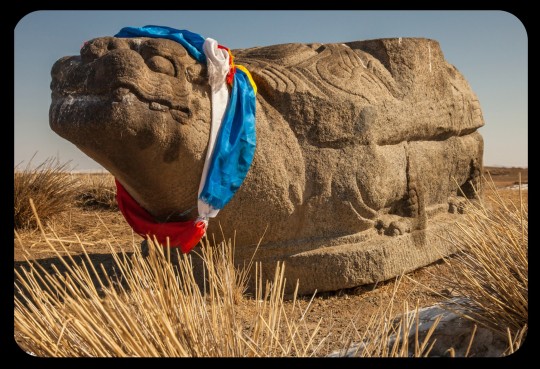
There is very little left of the ruined city today, and this statue is one of the few remaining features that can still be seen at the site. It originally formed the base of an inscribed stele, but the pillar section was somehow lost/destroyed, leaving nothing but the base (which may be a depiction of the mythological dragon-turtle, Bixi, from Chinese mythology).
This statue and the site in general always kinda remind me of the Ozymandias poem (the version by Horace Smith, not the one by Percy Bysshe Shelley):
In Egypt's sandy silence, all alone,
stands a gigantic leg
which far off throws the only shadow
that the desert knows.
"I am great OZYMANDIAS," saith the stone,
"the King of Kings; this mighty city shows
the wonders of my hand."
The city's gone —
naught but the leg remaining
to disclose the site
of this forgotten Babylon.
We wonder —
and some Hunter may express wonder like ours,
when thro' the wilderness where London stood,
holding the wolf in chace,
he meets some fragment huge
and stops to guess
what powerful but unrecorded race
once dwelt in that annihilated place
Sources & More Info:
University of Washington: Karakorum, Capital of the Mongol Empire
Encyclopedia Britannica: Entry for Karakorum
World History: Karakorum
#archaeology#history#anthropology#artifact#ancient history#mongol empire#mongolia#karakorum#middle ages#ancient ruins#art#turtle#bixi#ozymandias#poetry#mythology#genghis khan
256 notes
·
View notes
Text
Nayshall's clothing (pt. 1)
I'm gonna be 100% honest with ya'll. I was writing a Bosch smut and for the life of me, I didn't know the names of the clothes he was wearing. But I didn't want to put "Robes" and move on, so I did a deep dive into Nayshall's clothes.
Nayshall is a blend of multiple cultures in one, but the general consensus of forums on Reddit and other forums was that Nayshall was inspired by Bhutan, Nepal, Indian, and Tibet cultures.
This is going to be split into multiple of parts because Nayshall has a lot of different types of clothes so I won't be able to cover it in one sitting. I barely even scratched the surface here.
If anyone is more knowledgeable than me and sees that I got something wrong please tell me in the comments. But I'm posting this because I want people to see the hard work the street-fighting devs put into this and the world of Nayshall.
Chuba


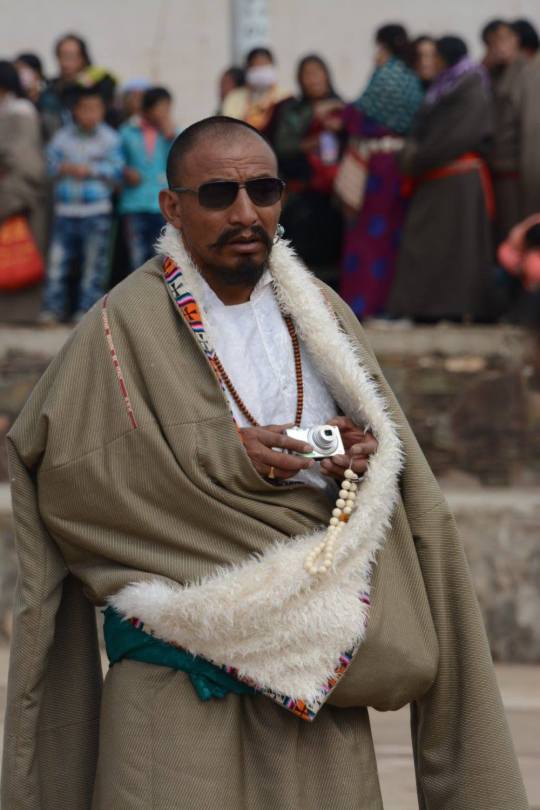
The chuba is a floor-length, left-crossing loose garment that is adjusted at the waist with a wide, usually red cloth belt, and pulled up to different degrees according to sex, rank or region. It is an extraordinarily adaptable garment worn by town dwellers, farmers, nomads, men and women alike, and is equally wearable on horse or motorcycle.
Chubas are pocket-less and held together with a waistband, with room in the front that serves as an “inside pocket” or inner pouch to store necessities such as food items, money belts, amulets, personal things, and even an infant in the bosom.
The chuba can be worn in different lengths, and the shorter the chuba, the more voluminous the pouch resulting from the overhanging material used to hold small items. Women wear their chuba ankle length, while men mostly pull them up the mid-calf or above the knee. Tibetan weather is fickle and temperatures can rise and fall within minutes.
Half-chupas: Just the skirt
Full chupas: Can be worn with a shirt
One-piece chupas: A one-piece dress
Town women: Wear their chubas floor length with pumps or high heel boots
Farmers and nomads: Double them over trousers
Ex: Rewancha, Yua, and Bosch all wore a form of chuba as their gown. The Chuba had 2 sleeves, but the locals usually only wear one sleeve and leave the other hanging loose. This is a way of adjusting the body temperature. When it gets hot, they take off one sleeve to cool down a bit. But if the temperature keeps rising they remove another sleeve too. We can actually see in Bosch's picture that the other sleeve is tucked in the back.
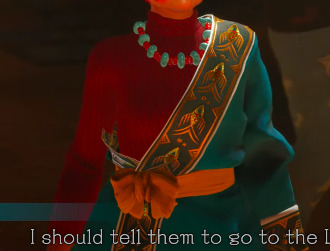


They often have soft fur, pulu, or colorful cloth on the collar, front, cuff, and lower hem of the gown.
5 types of robes could be made out of, Pulu woven fabrics, lambskin robes, sheepskin robes, woolen robes, and light robes.
Woolen robes are made with inner layers of sheep fur, so they are light and warm, making them popular in warmer, agricultural areas like Nayshall.
Pulu, the traditional Tibetan wool fabric, is made by fluffing and combing the wool into a thread by fingers, then weaving it with a wooden shuttle loom. Pulu robes are a favorite in pastoral areas as well as farmland.
Lambskin is ranked by degree, according to the length of lamb hair, curliness, and quality of the skin. 40+ lambskin is necessary to make a medium-class lambskin robe.
Shirts


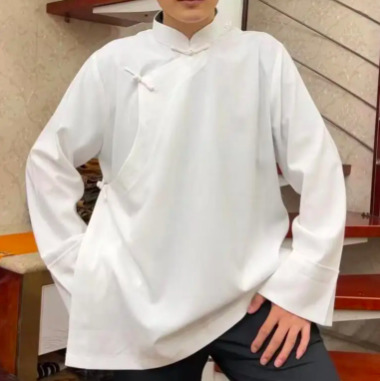
pants
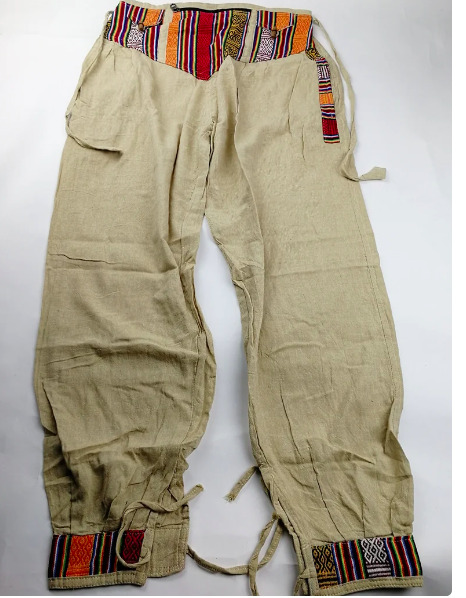
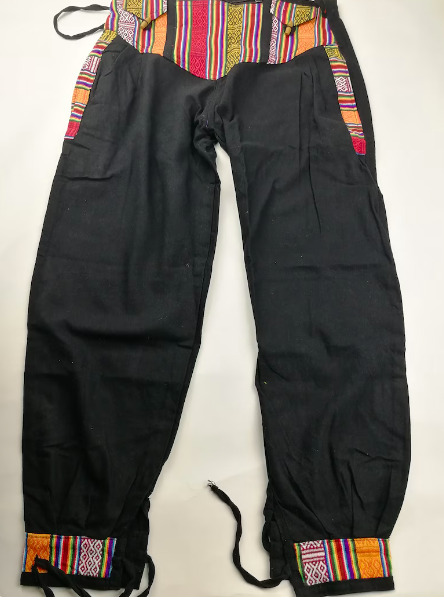

Modern and traditional
A growing trend among young Tibetans is blending traditional and modern casual clothing. Young Tibetans often try to find a balance between modern styles and their cultural heritage. It is not uncommon to see some Western-style clothing like jeans and t-shirts
The classic chuba robe is still everywhere, but Tibetan youth will make stylish adaptations. The cut of the fabric or the embroidered designs will be changed to something more contemporary. These changes show the desire to keep old traditions alive while making innovations to express personal style.
Ex. Same with the people in Nayshall they blend traditional and modern together. Shopkeeper Tsanpa wears jeans with his gho (Bhutan) tucked in. Yua wears modern shoes that resemble Tibetan boots, and Kina wears a beanie on top of her head.



note that Kina may also be wearing a Kora Yushu hat.
The Kora Yushu hat is made from a blend of yak and merino wool, and its fabric originates from Tibet and China. Kora sources the wool directly from Tibetan communities to ensure its quality and origin. The hat is lightweight, warm, and thin enough to fit beneath a hood or helmet, making it suitable for winter and mountain use.
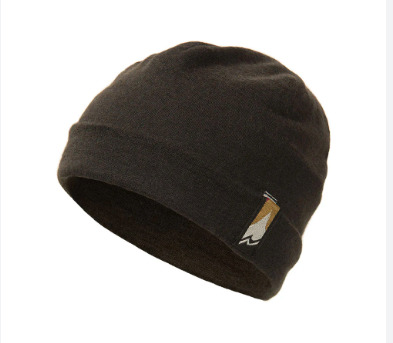
Hairbeads
Tibetan hair jewelry, including braids and hair beads, is used to mark life milestones like birth, marriage, adulthood, and death. The jewelry often reflects the colors of nature.
Tibetan hair beads can be used by both men and women. In Tibet, long hair was recommended for both men and women, except for monks and nuns. Tibetan braids can signal a woman's marital status, social rank, and tribal affiliation. Tibetan men wear hair beads but there is no male equivalent.

Headdress
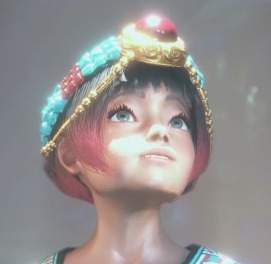

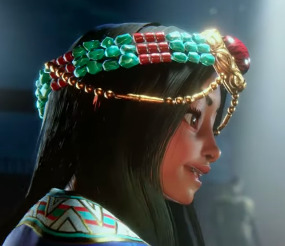
Tibetan headdresses vary by region, age, and marital status. For example, unmarried girls wear a single braid with a red hair string, called Xia Jiu in Tibetan.
Tibetan women wear headdresses on special occasions, such as festivals and their comings-of-age. Headdresses can be colorful and made of coral, turquoise, or other materials. For example, a "Bazhu" is a deluxe headdress made of coral or turquoise with gold or silver earrings. Tibetan women also wear silver bracelets on their left hand and white conch bracelets on their right.
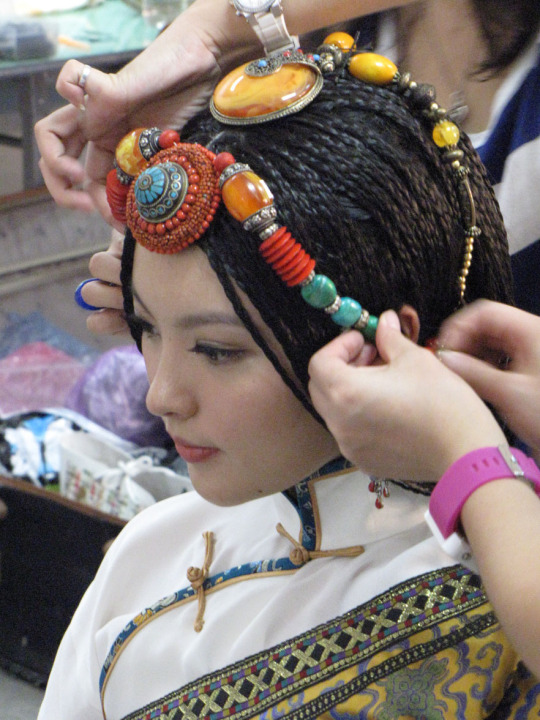

Jewelry


Tibetans traditionally wear jewelry, which is often made from gold, silver, and precious stones. The most common gems used are turquoise, coral, and pearls, which are used in necklaces, earrings, hair ornaments, and to decorate ritual objects. Tibetan jewelry can also be made from cow bone, amber, shell, and agate.
Tibetans wear a variety of jewelry, including ornaments made of gold and silver, as well as jewelry made of amber, agate, jadeite, pearl, and ivory. Tibetan jewelry traditionally features materials from across South Asia, East Asia, and the Middle East, and the symbols on Tibetan jewelry are usually from Himalayan Buddhism. Tibetans like to wear many ornaments and jewelry, such as Buddha beads, hair bands, hair accessories, belts, prayer beads, and necklaces.
Jewelry is a symbol of status and wealth in Tibetan culture, and each design has a specific meaning. For example, ornaments with symbols of animals, flowers, and stones are often given to commemorate special occasions. Some also believe that wearing gold enhances spiritual power over evil spirits. Offering jewelry to holy statues is thought to generate positive virtue for the donor.
This article also goes into the types of ornaments they use in their jewelry
Jewelry can also serve as a talisman, with different amulets protecting against disease and harm. For example, coral and turquoise are said to ward off evil spirits and illness.
Many Tibetan jewelry pieces are passed down from generation to generation. For example, some Tibetan-style pendants are used in Buddhism as ritual instruments to subdue demons, which are believed to dispel sins and bring people power, intelligence, and courage. Many of these pendants also have Sanskrit inscriptions of a religious symbolic nature.
Braids
Braids are also a symbol of strength, wisdom, and identity for some indigenous men and boys. They can also represent a connection to the earth, ancestors, and the creator. For example, in Native American tradition, hair is a signifier of spiritual practice, and braiding demonstrates strength in unity
boots
sumba shoes

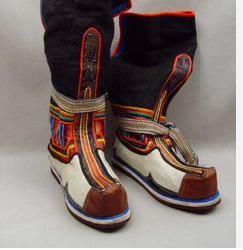
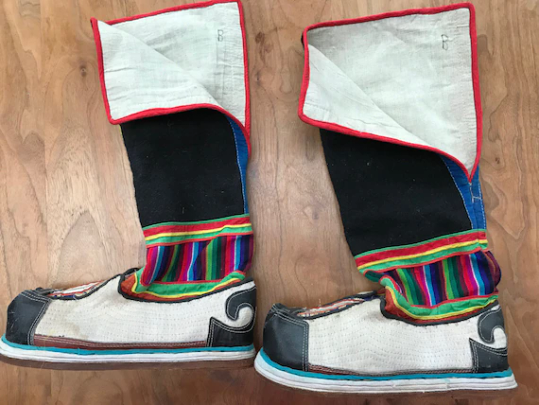
Tibetans typically wear boots, which are more cultural representations than practical clothing. However, due to the prevalence of mass-produced shoes, traditional Tibetan boots are no longer the daily footwear for ordinary Tibetans. Instead, they are now usually part of ceremonial attire.
Tibetan boots are a significant part of the Tibetan way of life. They are more cultural than practical, and are worn to represent different regions and environments. For example, boots with a pointed toe are suitable for different types of terrain, and can be worn with a garter in cold weather. Boots from different regions of Tibet have different styles and qualities. For example, boots from Chamdo and northern Tibet are simple, while boots from Shannan and Xigaze are more delicate.
Tibetan boots are commonly made from cowhide, pigskin, corduroy, and pulu, a traditional woolen fabric. Other materials used include cloth, canvas, velvet, leather, and felt. The original boots were made from yak hide, and the soles were embroidered with patterns like dragons and snakes, and the shoes were decorated with red and green woolen cloth.
Tibetan boots come in two general types: short leg and long leg. Most Tibetan boots are lined or padded, though some may be unlined. The heads of corduroy boots are made of cowhide, and many kinds of pulu boots have cowhide soles.

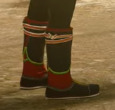
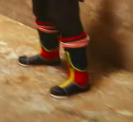
17 notes
·
View notes
Text
THIMPHU, BHUTAN STREETART: PROTECTION
This mural on a building in Thimphu features traditional Bhutanese symbols commonly seen to convey protection, spiritual significance, and cultural identity. From top to bottom: Dragon – A powerful emblem of protection and the guardian of treasures. In Bhutanese culture, it is also associated with Druk (Thunder Dragon), which is central to Bhutan’s identity as the “Land of the Thunder…

View On WordPress
#art#Bhutan#murals#photography#Street Art#thimphu#TOKIDOKI Nomad blog#TOKIDOKI Nomad travel blog#Travel#World Travel
5 notes
·
View notes
Text
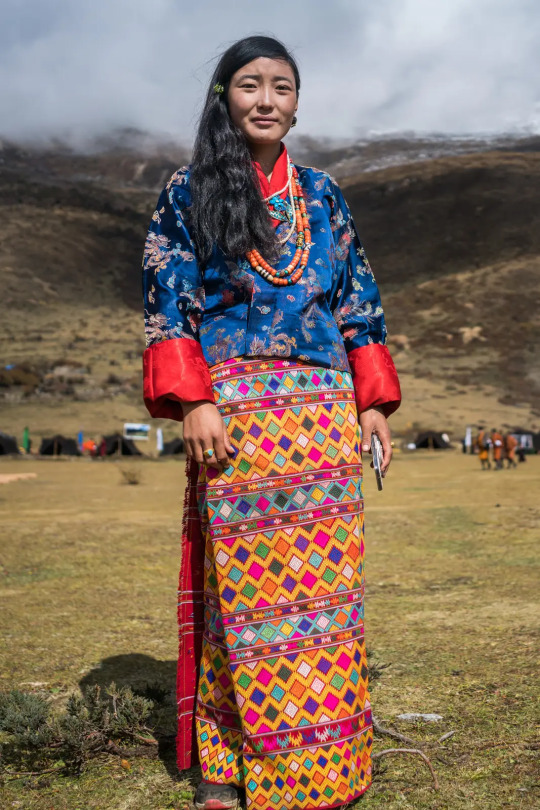
Bhutanese woman, Bhutan, by Lost With Purpose
#bhutanese#bhutan#asia#south asia#folk clothing#traditional clothing#traditional fashion#cultural clothing
660 notes
·
View notes
Text
youtube
Bhutan seems to be leading the way towards a Solarpunk future. No factory farming, but they clearly use modern technology where it makes sense (like churning butter).
The other thing that strikes me, is that by mandating everyone wears traditional clothing and that traditional architecture is maintained - their culture hasn't swept away in the tide of capitalism and globalization.
I'm certain this isn't perfect, nothing is, but they seem to have some really clever ideas that are keeping their land healthy and beautiful. I'd totally go, but all that casein would make me really sick. I wonder what their rate of autoimmune disorders is... I want to believe it's lower due to a lack of pollution. But, I have absolutely no data to back that up.
4 notes
·
View notes
Text
Best Places to Travel in November
Best Places to Travel in November is a fantastic month for travel. The weather is mild, and the crowds are fewer. As the year winds down, the urge to escape grows stronger. November offers a unique blend of experiences. From tropical beaches to snowy mountains, there's a destination for everyone. This month is perfect for those seeking relaxation or adventure. Whether you're looking to bask in the sun or embrace a winter wonderland, November has it all. The options are vast and varied, ensuring a memorable trip. So, pack your bags and get ready to explore. Let’s dive into the best places to travel this November.
Nepal
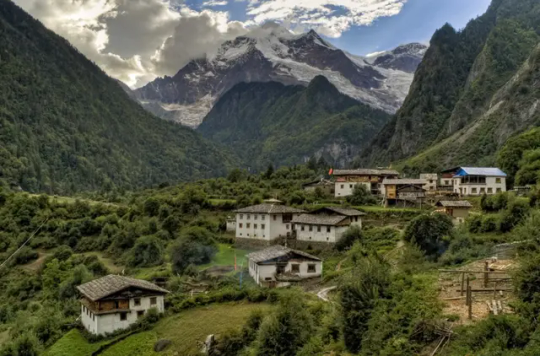
Nestled in the heart of the Himalayas, Nepal is a land of breathtaking landscapes, ancient traditions, and warm hospitality. Renowned as the home of Mount Everest, the highest peak in the world, Nepal offers adventurers a haven for trekking, mountaineering, and exploring pristine natural beauty. For cultural enthusiasts, the country is steeped in rich history with UNESCO World Heritage Sites like Kathmandu Durbar Square, Bhaktapur, and Lumbini—the birthplace of Lord Buddha. The serene monasteries, vibrant festivals, and diverse ethnic cultures create a unique charm that captivates every traveler. Whether you’re seeking adrenaline-filled adventures, spiritual retreats, or a peaceful escape, Nepal is a destination like no other.
Japan
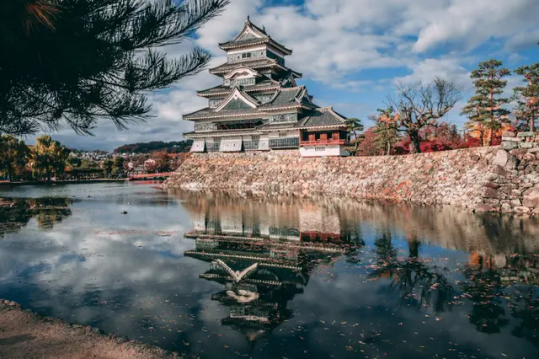
Japan is a mesmerizing blend of ancient traditions and cutting-edge modernity. From the serene temples of Kyoto and the iconic Mount Fuji to the bustling streets of Tokyo, every corner of Japan tells a unique story. Immerse yourself in the rich cultural heritage through traditional tea ceremonies, geisha performances, and centuries-old shrines. Explore the natural beauty of cherry blossoms in spring, vibrant autumn foliage, and tranquil hot springs year-round. For food lovers, Japan is a paradise with sushi, ramen, and other culinary delights to savor.
Thailand
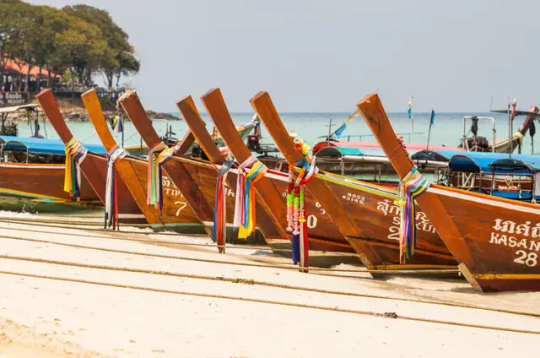
Thailand, the "Land of Smiles," is a paradise for travelers seeking culture, adventure, and relaxation. From the golden temples of Bangkok to the tranquil beaches of Phuket and Krabi, Thailand offers a stunning mix of experiences. Explore the bustling street markets, savor the world-famous Thai cuisine, and dive into the turquoise waters of tropical islands. Adventure awaits in the lush jungles of Chiang Mai, while spiritual peace can be found in ancient temples and serene monasteries.
Vietnam

Vietnam is a captivating destination known for its stunning natural landscapes, rich history, and vibrant culture. From the emerald waters of Ha Long Bay to the terraced rice fields of Sapa, the country offers breathtaking scenery at every turn. Discover the bustling energy of Ho Chi Minh City, the ancient charm of Hanoi, and the peaceful lantern-lit streets of Hoi An. Savor the world-famous Vietnamese cuisine, from pho to banh mi, as you explore local markets and street food stalls.
Bhutan
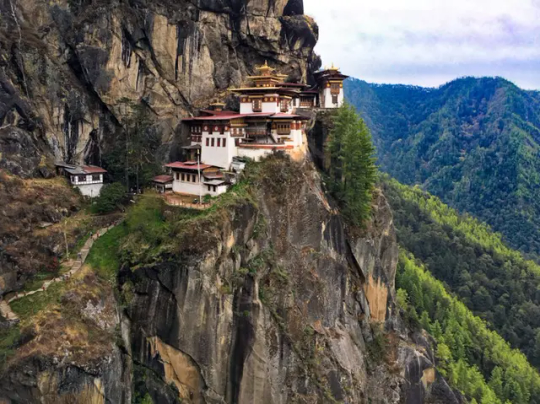
Bhutan, the "Land of the Thunder Dragon," is a hidden gem nestled in the Himalayas, known for its breathtaking landscapes and deep-rooted traditions. As the world's only carbon-negative country, Bhutan offers pristine natural beauty, from lush valleys to snow-capped peaks. Explore ancient monasteries like the iconic Tiger’s Nest, vibrant festivals, and the unique philosophy of Gross National Happiness.
Maldives

Maldives, a tropical haven in the Indian Ocean, is the ultimate destination for relaxation and luxury. Famous for its crystal-clear waters, powdery white sand beaches, and overwater villas, this island paradise offers unmatched beauty and tranquility. Dive into vibrant coral reefs, enjoy world-class water sports, or unwind as you soak in breathtaking sunsets. The Maldives is also a romantic escape, perfect for honeymoons and intimate getaways.
Morocco
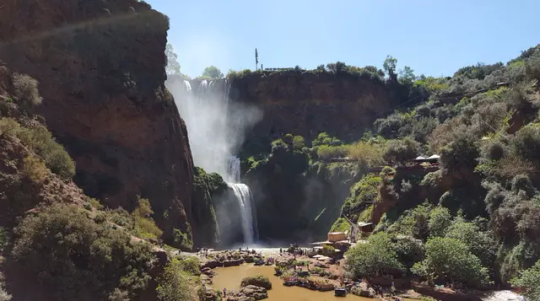
Immersing in rich history, unique landscapes, and vibrant cultures. Known for its vibrant souks (markets), historic palaces like the Bahia Palace, and lush gardens such as Jardin Majorelle. The city's bustling Djemaa el-Fna square offers a sensory overload with food stalls, entertainers, and local artisans. Experience camel trekking through vast sand dunes, camp under the stars in traditional Berber tents, and enjoy the tranquility of the desert. The desert's beauty is even more magical during the cooler evenings of November.
Italy
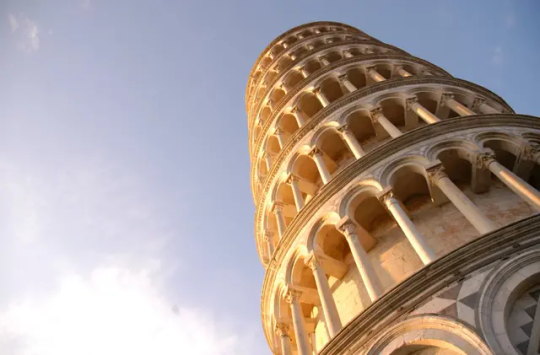
Experiencing Italy's rich culture, history, and beautiful autumn landscapes. Best Places to Travel in November marks the harvest season for grapes and truffles. Explore the picturesque vineyards and wineries, enjoy wine-tasting tours, and indulge in delicious seasonal foods. It's the perfect time to experience the charm of the Tuscan countryside. Rome the eternal city’s iconic sites like the Colosseum, Roman Forum, and Pantheon are less crowded in November, offering a more relaxed experience while soaking in the history.
India
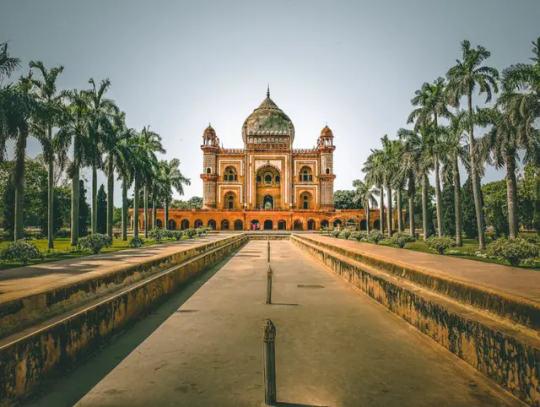
India, a land of diverse cultures, rich history, and stunning landscapes, offers something for every traveler. From the majestic Taj Mahal to the peaceful backwaters of Kerala, India’s beauty and charm are endless. Explore vibrant cities like Delhi and Mumbai, immerse yourself in the spiritual aura of Varanasi, or trek through the Himalayan peaks. India’s festivals, cuisine, and traditions offer a truly unique experience.
Sri Lanka

Sri Lanka, a tropical island in the Indian Ocean, is a haven of diverse landscapes, ancient history, and vibrant culture. From the golden beaches of the south to the lush tea plantations in the central hills, every corner of Sri Lanka is a new adventure. Explore the ancient cities of Anuradhapura and Polonnaruwa, climb the iconic Sigiriya rock, or relax along the pristine shores of Mirissa and Unawatuna. Sri Lanka’s rich wildlife, flavorful cuisine, and warm hospitality make it a perfect destination for nature lovers, history buffs, and beach enthusiasts alike.
Indonesia

Indonesia, a vast archipelago of over 17,000 islands, offers an extraordinary range of experiences. From the tropical beaches of Bali to the majestic volcanoes of Java and the lush jungles of Sumatra, Indonesia is a paradise for nature lovers and adventure seekers. Immerse yourself in vibrant cultures, visit ancient temples like Borobudur, or enjoy world-class diving in places like Raja Ampat. Indonesia’s rich history, diverse wildlife, and delicious cuisine create a truly unforgettable travel experience.
Cambodia

Cambodia is a country steeped in history, culture, and natural beauty. Known for the awe-inspiring Angkor Wat, the world’s largest religious monument, Cambodia offers travelers a glimpse into ancient civilizations and stunning architecture. Beyond its temples, Cambodia’s vibrant cities like Phnom Penh and Siem Reap, lush jungles, and peaceful beaches provide diverse experiences. Discover the rich heritage, explore the countryside, or relax by the coast in this charming Southeast Asian gem.
Singapore
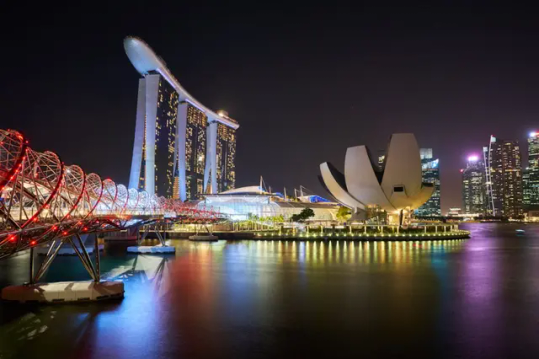
Singapore is a dazzling city-state that blends modern innovation with rich cultural heritage. From the futuristic Gardens by the Bay and iconic Marina Bay Sands to the bustling streets of Chinatown and Little India, Singapore offers a dynamic travel experience. Explore its world-class shopping districts, indulge in diverse cuisines, or relax in lush green spaces like East Coast Park. Whether you're discovering its vibrant nightlife, admiring architectural wonders, or enjoying its family-friendly attractions, Singapore is a perfect destination for all kinds of travelers.
South Korea
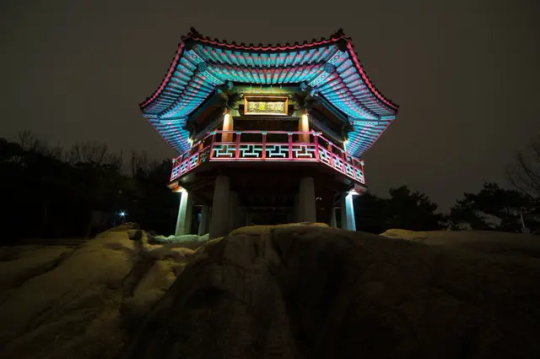
South Korea is a captivating blend of modern innovation and ancient traditions. From the high-tech streets of Seoul to the tranquil temples and palaces of Gyeongju, South Korea offers a unique journey through time and culture. Explore vibrant neighborhoods like Gangnam, hike scenic trails in the mountains, or visit historic sites like the Gyeongbokgung Palace. Indulge in delicious Korean cuisine, from kimchi to BBQ, and immerse yourself in the lively K-pop culture. Read More travel place
#traveling#best places to travel#air travel#best places#travel#business class flight#beautiful place#cheap flight deals#cheap flight fares#cheap flight ticket#travel india#tourism#travel photography#travel blog
2 notes
·
View notes
Text

Embark on a journey to Bhutan in August and discover vibrant landscapes and cultural richness. Immerse yourself in the serene beauty of 10 handpicked destinations that promise an unforgettable vacation experience. From Thimphu's mystical monasteries to Punakha's lush valleys, each spot unveils a unique facet of Bhutanese charm. Embrace the warmth of local hospitality, savour traditional flavours, and create lasting memories in this enchanting Himalayan haven—Unveil Bhutan's August allure with this curated guide to an extraordinary getaway.
#August in Bhutan#Bhutan in August#Weather In Bhutan In August#vibrant destinations#Bhutanese culture#Himalayan vacation#Thimphu monasteries#Punakha valleys#local hospitality#traditional flavours#enchanting getaway.
0 notes